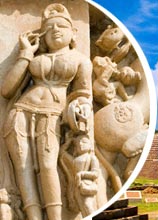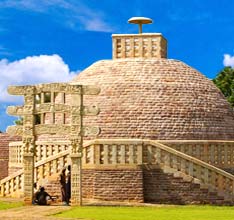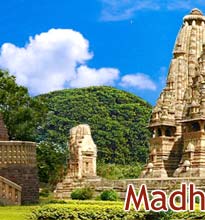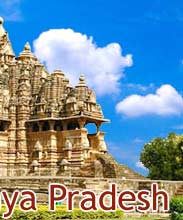 Madhya
Pradesh is a land that exudes vibrancy from all its alcoves. It not only
cradles people belonging to different religions and communities, but is
also home to numerous exotic tribes of India. This has led to its unique
cultural and religious matrix that poses a colorful stance, as far as
its festivities are concerned. These fairs and festivals interweave all
the people of Madhya Pradesh in a common web and see much aplomb and
gaiety throughout the state. In fact, the spirit of celebration is
entrenched in the culture and tradition of Madhya Pradesh and finds best
expression through these different seasons of revels.
Madhya
Pradesh is a land that exudes vibrancy from all its alcoves. It not only
cradles people belonging to different religions and communities, but is
also home to numerous exotic tribes of India. This has led to its unique
cultural and religious matrix that poses a colorful stance, as far as
its festivities are concerned. These fairs and festivals interweave all
the people of Madhya Pradesh in a common web and see much aplomb and
gaiety throughout the state. In fact, the spirit of celebration is
entrenched in the culture and tradition of Madhya Pradesh and finds best
expression through these different seasons of revels.The rich cultural riches of Madhya Pradesh have indeed, led to the birth of many religious and cultural festivals. A major progenitor of art, in the form of dance and music, the state revels in traditional cultural festivals that exalt these art forms. In fact, two of its most famous festivals- the Khajuraho Dance Festival and the Tansen Music Festival celebrate the traditional art forms of dance and music. Apart from these spectacular vaudevilles, various tribal festivals of the state add on to its festive spirits. Here, we have provided information on the major festivals of Madhya Pradesh.
Khajuraho Dance Festival
No one can deny the entrancing aura that envelops the cluster of temples in Khajuraho. These monuments are the finest examples of the fusion of beauty, spirituality and sensuality, which delineates art in its most spectacular form.
Bhagoria Festival
The tribal people of Madhya Pradesh form an important part of its culture and contribute to the colorful graffiti of the state. They have their indigenous norms, moral yardsticks and tribal heritage that they strive to preserve. This unique tradition and vibrant culture comes alive in the Bhagoriya festival of Jhabua.
Tansen Music Festival
Hindustani Classical Music is known for its poignant ragas and mellifluous notes and showcases its musical splendor in the form of Tansen Music Festival, held in Gwalior every year. Gwalior, acclaimed as the oldest Gharana in Hindustani music, has managed to retain its musical spirit and tradition.
Mandu Festival
Madhya Pradesh, known for its overpowering gaiety and pomp during festive celebrations, exhibits the Mandu festival every year with the same exulting fervor. This festival falls in September/October and coincides with the celebration of Ganesh Chaturthi in other places.
Kumbh Mela
Kumbh Mela is the largest religious congregational fair of the Hindus and has known celebration from many centuries. This pilgrimage is observed four times every twelve years, at each of these four places - Prayag, Ujjain, Haridwar and Nashik. The celebration of Kumbh Mela sees the convergence of millions of devotees, shamans, monks and religious saints across India, making the festival the largest of all Hindu fairs. According to astrologers, Kumbh Mela takes place when the planet Jupiter enters Aquarius and the Sun enters Aries.
Karma
One of the most important religious festivals of Madhya Pradesh, Karma originally belongs to the list of festivals celebrated by the Korba tribal. However, other tribes too participate in the merriment of the Karma. The festival falls in the month of August. People undergo a full day, fast from the morning of the festive day to the morning of the next day. During the night, people indulge in singing, dancing and merrymaking, around a branch of Karam tree.
Fair of Nagaji
Nagaji fair or 'mela' of Madhya Pradesh is popular amongst the tribal people and is a way of paying homage to Saint Nagaji, who lived at the time of Emperor Akbar, nearly 400 years ago. With the onset of the winter season, generally in November or December, the adivasis or tribals congregate at Porsa village in the Murena district. They stay there for about a month and indulge in various communal activities that bring about lot of conviviality and merry making. Various domestic animals traded in the markets form a major draw of this fair.
Madai Festival
The Madai festival, held at various tribal hamlets of the state, is especially dear to the people belonging to the Gond community. This festival takes place in the third or fourth week of February. Though it is a gala event, marked by singing and dancing, yet the religious overtone of the festival remains evident. During Madai, devotees assemble under the shade of a sacred tree and make sacrificial offerings, in the form of a goat, to the Mother Goddess. During the night, the tribal people gloat and make merry.









